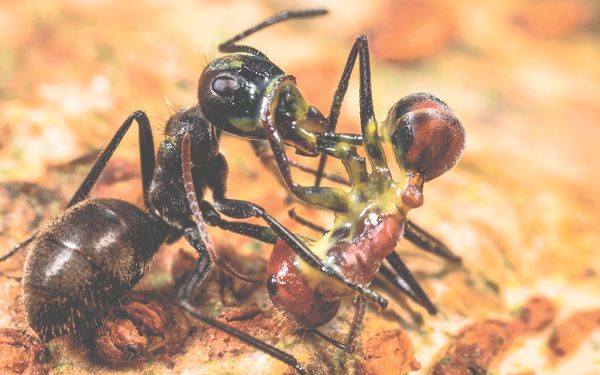The more than 13,000 ant species around the globe have developed a diverse array of nest protection methods. Some spray toxic venoms; others erect rock blockades. Amid the lowland rainforests of Southeast Asia and India, however, there’s a group of ants with a particularly gutsy defensive technique: They explode, showering their enemies with killer goop and sacrificing their own lives in the process.
Experts are aware of at least 15 species of exploding ants, all members of the genus Colobopsis. The best-studied species, C. explodens, forms thousands-strong colonies in and around tropical trees. The workers spend their time grazing on lichen- and moss-covered tree bark, guarding the colony’s nest entrances, or patrolling and foraging way up in the canopy, often hundreds of feet off the ground.
Each worker is equipped with a pair of oversized, goo-producing glands, which extend from her head throughout her entire body. When confronted by a threat—another insect, or even an approaching scientist—she squeezes her abdomen until these glands rupture and her whole body pops open like a zit.
The ooze produced by C. explodens is booger yellow and has a spicy smell. (Scientists called the species “yellow goo” until 2018, when it received its much more respectable, and intimidating, scientific name.) While the gunk doesn’t appear to be especially poisonous, it is extra-sticky and stops opponents in their tracks like an on-demand liquid fly trap. It’s also antimicrobial, suggesting that the ants might have used it for keeping their nests clean before this deadlier function evolved.
In order to maximize impact, these mini bug bombs will strategically set themselves off after glomming onto an opponent’s leg or head. For a few ambitious ants observed by researchers, this meant gluing themselves to grasshoppers an estimated 20 times their size.
This behavior—altruistically exploding to expel something harmful at an enemy— has an official name: autothysis, from the Greek for “self-sacrifice.” A few other insects are known to exhibit it, including termites of the species Neocapritermes taracua, which live in the rainforests of French Guiana. These termites develop what experts have dubbed “explosive backpacks”: sacs of crystals that grow increasingly toxic as the termites grow older. During battle, the oldest workers rupture these sacs, along with their salivary glands, mixing the contents of the two. This initiates a chemical reaction, producing a sticky, toxic cocktail that kills the enemy and the termite both: more bugs going out with a bang.
Range: Southeast Asia and parts of India
Species: Colobopsis explodens
How to see them: You can catch a glimpse of the exploding ants at the Kuala Belalong Field Studies Centre in Temburong District, Brunei.
Wild Life: An Explorer’s Guide to the World’s Living Wonders celebrates hundreds of surprising animals, plants, fungi, microbes, and more, as well as the people around the world who have dedicated their lives to understanding them. Pre-order your copy today!


